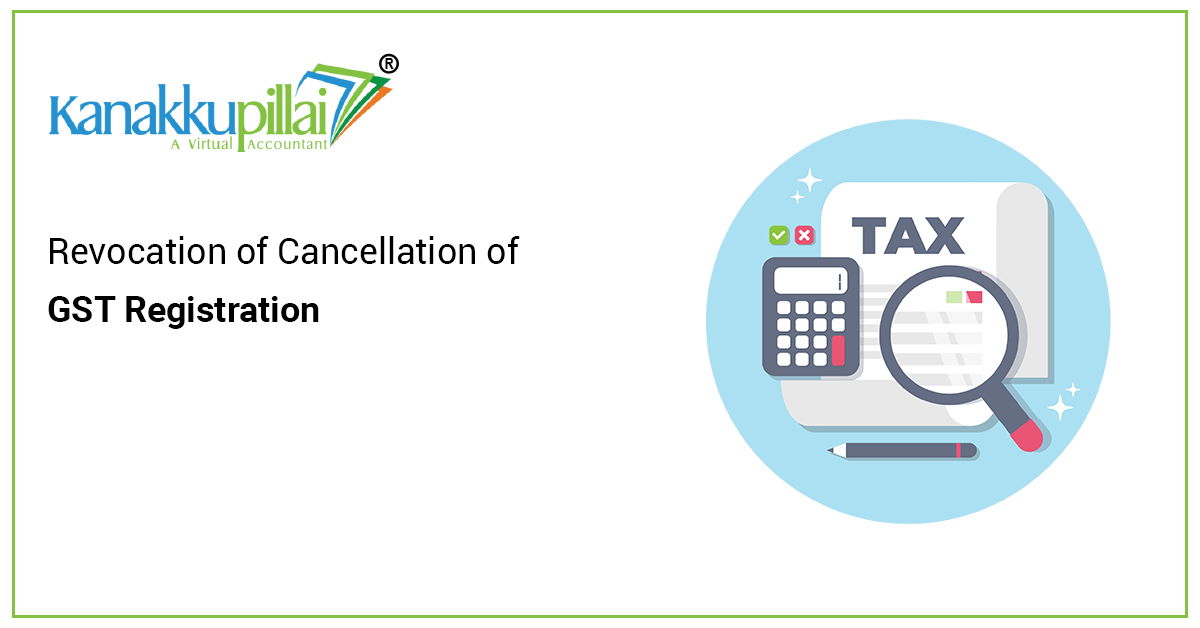India has a Goods and Services Tax (GST) system, under which all eligible businesses must obtain and maintain an active GST registration. It enables companies to raise the GST charged to customers, input tax credit, and conduct business within the law. But when a taxpayer does not comply with GST laws, e.g., by failing to file returns or breaking the law, the tax authorities can cancel his registration. This cancellation can interfere with business processes, obstruct input credit, and even erode client confidence.
To address an authentic situation, the law permits taxpayers to seek revocation or cancellation of their GST registration so they can reclaim it upon compliance. The process helps businesses return to normal operations, even though the GST obligation must be paid.
Meaning of Revocation of Cancellation
Revocation of cancellation of GST registration merely comprises restoring a cancelled GST registration. It applies when the tax officer himself cancels the tax, not when the taxpayer requests it.
When the taxpayer rectifies his/her defaults, e.g., by submitting outstanding returns or paying outstanding tax dues, he/she may apply online to have the revocation done. If approved, they can restart their GSTIN and operate their businesses without any hindrance.
Legal Framework Governing Revocation
Section 30 of the Central Goods and Services Tax (CGST) Act, 2017 and Rule 23 of the CGST Rules, 2017, define the concept of revocation. These terms are very clear with regard to who is allowed to apply, the time limit and how they will be done.
Under Section 30, an individual whose registration has been cancelled by the proper officer has a period of thirty days to apply for revocation on the date the order of cancellation is served. In deserving cases, this period may be extended by the Additional Commissioner or the Commissioner.
This is a safeguard so that good taxpayers who committed unintentional errors or delays are accorded a reasonable chance to recover their business registration.
Common Reasons for GST Registration Cancellation
The authorities may cancel the registration of GST based on a number of non-compliances. There are certain typical cases, such as:
- It includes failure to file GST returns continuously for a period of six months or more.
- Late payment of tax, interest or penalty.
- GST registration by false representation or misrepresentation.
- Failure to conduct business in the stated location of business.
- GST laws were violated, or the provisions of input tax credit were abused.
In case the cancellation takes place because of such reasons, the taxpayer is allowed to apply for revocation after the corrections of the defaults are made.
Time Limit to Apply for Revocation
The period allowed to lodge an application for the revocation or cancellation of GST registration is 30 days from the date of the cancellation order. Nevertheless, it is possible to expand this time, given the practical challenges.
- An extension of up to 30 more days may be given by the Additional Commissioner or Joint Commissioner.
- Another extension can be given to it by the Commissioner up to another 30 days.
In effect, a taxpayer can be allowed a maximum of 90 days to apply, although the competent authority has to approve the request.
Prerequisites for the Revocation Application
Some compliance conditions should be met before one requests revocation. The taxpayer should ensure that pending GST returns are filed by the date of cancellation. The interests, penalties, taxes, and any other overdue amounts should be paid.
If the registration is cancelled for failure to file returns, the taxpayer must first file returns before filing the revocation application. Failure to comply with these requirements may result in the department rejecting the application.
Procedure for Revocation of GST Registration
The revocation is an entirely online process that can be easily completed on the official GST portal.
Step 1: Log in to the GST Portal
Go to the official site at www.gst.gov.in and log in using a valid username and password.
Step 2: Click on Revocation Option
Then, in the tab Services, choose Registration – application to revoke cancelled registration.
Step 3: Present Reason of Revocation.
Type in the cause of revocation, e.g. late filing of returns, technical problem or lack of funds. Please add any supporting material as needed to support your request.
Step 4: Submit the Application
Once all the information has been filled in, press the Submit button with Digital Signature Certificate (DSC) or Electronic Verification Code (EVC). An application reference number (ARN) will be created.
Step 5: Department Review
The application and documents are examined by the jurisdictional officer. When the officer is content, he or she may grant the revocation by issuing a form in GST REG-22.
In case the officer needs further explanation, then he/she has the right to give a notice in Form GST REG-23 whereby the taxpayer is required to respond within seven working days in Form GST REG-24.
Importance of Revocation for Businesses
Revocation plays a critical role in businesses because cancellation results in the suspension of the GSTIN, which does not allow carrying out a legal sale or collecting input tax credit. It also impacts relations with clients and vendors. Timely revocation ensures:
- Incidents of continuity of business operations.
- Reinstatement of eligibility for input tax credit.
- Escaping fines on unregistered businesses.
- Better tax authority compliance history.
Therefore, revocation protects a business’s reputation and legal status under GST.
Conclusion
A business can easily revive its GST registration by using pending returns, paying dues, and filing the revocation application within the required time so that it can resume its legal operations. Businesses would seek professional help in filing revocation applications, compliance management and GST registration services through Kanakkupillai. This reputable platform provides end-to-end GST and legal services to other entrepreneurs in India.





